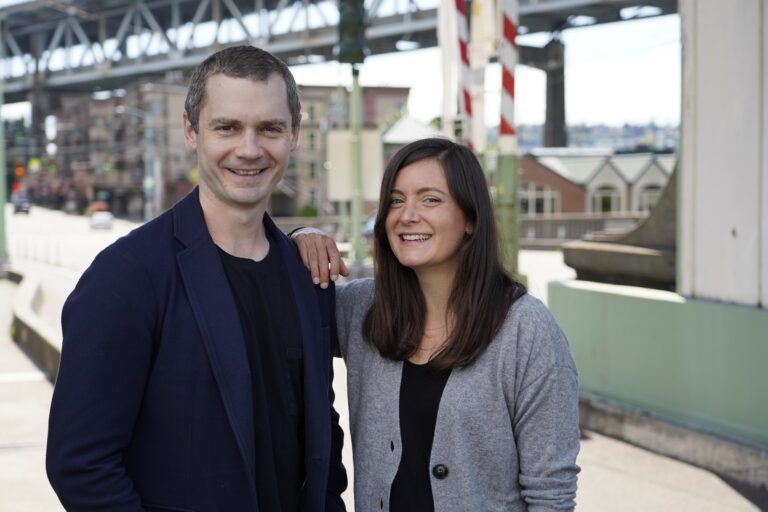
A Convo With Sydney Badger–
Making Sustainability a Public Habit
“If companies like [Amazon] don’t get influenced by small movers and shakers like Public Habit, we are screwed. We are toast. And so if we can get more customers to just understand a little bit more about how their choices may have an impact, it’s going to be worth it. It’s got to be worth it.”
Sydney Badger
In between the manufacturing and rollout of the “Cassandra powered by Public Habit” line, Cassandra had a chance to sit down with Public Habit co-founder, Sydney Badger. Together they discussed the origins of the Seattle based brand and the innovative future of collaborative, sustainable manufacturing in China.



How did you get started? What’s your background in the industry?
I’ve spent almost 12 years in the industry between Ralph Lauren and Amazon, two very, very different retail companies. I kind of fell into fashion after living and working in China for a number of years after college. I got to witness a lot of the rapid development that was going on in cities like Shanghai and across the country in the late 2000’s. Then I wanted to stay as connected to China as possible. So I joined Ralph Lauren on the Asia-Pacific buying team and I got to be a buyer for the luxury labels. I got to see the inner workings of a beautifully curated brand. It was just a really good fit for me. It was very left brain. What are people going to want? What is this customer in Asia going to want specifically?
Ultimately I wasn’t a Ralph Lauren “until I die” kind of merchant or buyer. When Amazon recruited me in 2013, that seemed like a very interesting and different way to go. I got to join Amazon Fashion’s team as they were growing quickly in 2013 through 2018 when I left to start Public Habit.
Between those two very different experiences, I fell in love with fashion.
I fell in love with the dreaminess of it, the artistic quality, the creativity behind it (that was not my skill set). But I also really liked the science behind trying to figure out what people were going to want. It was so different. I mean, you think about the difference of how you curate for a brand like Ralph Lauren and how you do [the same] for a storefront like Amazon. Because of that I kind of felt a bit soulless after my time at Amazon. I wanted to connect more closely to the product.
I took a leap with my now co-founder of Public Habit to start something that would enable us to get back into fashion. We didn’t really have much of a concept at the time in 2018. But we knew we wanted to find some way to bridge the experience of a Ralph Lauren with the accessibility and efficient operation of an Amazon. And we thought that fashion was just so far behind in terms of how the industry was thinking about making and delivering products to the customer.


We initially set out on a very simple journey to make a line of T-shirts that would basically be at a better price than Vince but at the same quality. We understood the economics behind what that takes. But we didn’t understand why all these brands were charging these ridiculous markups just because they had a fancy brand name.
To us, that didn’t make a lot of sense.
We also knew from the industry that a lot of these products made by Brand “X” are also made at the same factory as all of these lower priced brands. They’re products that were made in the same factories. But you can charge a hell of a lot more because it’s one brand name over another.
What we didn’t know was the sheer amount of waste in the industry. I don’t think that we expected that to be kind of a turning point for us and how we were going to figure out the business we wanted to build. We got over to China, saw the source of these T-shirts and we started recognizing that there were so many inefficiencies in the supply chain that were creating waste. The biggest reason for all this is because brands over the course of the last 50 years have had to start moving their production overseas further and further away from the customer to get the lowest cost sourcing so that they could make the most profit possible.
They’re seeking out the lowest prices and they need to develop really high volumes. Which ultimately means they make way more than they need. They’re also producing in factories where people are going to be making less than 50 cents an hour. I mean, these prices are ridiculous. There’s no way to buy a ten dollar dress from a retailer that was made “sustainably” where people along the chain are actually treated well.
We needed to think about a different model.
Over the course of the next year and a half, we thought, what would happen if we’ve totally flipped this model? We started with what customers wanted and then we went and made it. So we don’t make anything unless a customer says they want that specific thing. We found some amazing partners overseas in China who are already thinking this way about how to dramatically rethink the supply chain to be more efficient and more sustainable. That’s been our whole mission behind Public Habit –– how do we stop the supply chain? Make only what we sell and make sure that everyone along the chain is paid appropriately.

How does Public Habit define sustainability?
In the last 10 years, we actually think about it in two ways. We think about sustainability in terms of the impact on the planet that we’re making and we think about it in terms of the longevity–the ability for us to actually sustain a business for the long term. The first one is really about mindfulness–sustainability in terms of the impact that the business has on the environment, on society, on all stakeholders. It is critical for us to have longevity and credibility as a business. For too long all of these partners along the chain have been seen as disposable.
The other piece that comes down to a sustainable business model is about the fact that the fashion supply chain and the fashion industry is not sustainable. It is not going to be sustainable for businesses to keep trying to make more products cheaper and to keep up with consumer demand.
I love asking companies that I admire that question because I just think it’s something we need to keep redefining and unpacking. What are we doing well and what are we not doing? Do you ever struggle with producing clothes in this current global crisis?
I think about it a lot because fundamentally, as we all know, the most sustainable thing we could do is never buy another garment again. We’ve already produced more on the planet than we need for the next 10+ years. Despite our model and despite the fact that we aren’t going out and producing in bulk, we’re still putting new products out in the world and we’re still in the business of selling things to customers. I think it’s a good tension to have. If companies like [Amazon] don’t get influenced by small movers and shakers like Public Habit, we are screwed. We are toast. And so if we can get more customers to just understand a little bit more about how their choices may have an impact, it’s going to be worth it. It’s got to be worth it.
One of the main things I love is demystifying things that seem hard. I’d like to give readers a bit of insight into how you chose your factory.
Where you produce your final goods is also not the whole story. I think that the clothing industry is one of the most human intensive industries out there that touches so many people–from raw materials to finished goods to actual logistics and sales. Our focus is on the sourcing side, which is really important to how we established our model.
China is the one of the oldest manufacturing centers of textiles in the world. And most notably probably the best with the best technical aspect as well as the best ability to scale up. They’re also the ones to understand the impact the best in a way that really amazed me. Imagine growing up in a city where your uncle, your cousin, your best friend all worked in manufacturing–that’s China. It’s part of their DNA in the last 50 years. To that end, I felt like the conversation was so much further along from the conversations I was having with factories in the U.S.
The biggest thing that they enabled was a really flexible, on-demand supply chain. They’d actually upgraded their facilities so that producing one unit was just as efficient as producing a thousand units. That’s where it usually breaks down for most manufacturers. They need to produce at a scale that makes sense for them from an economic standpoint and that’s where you get into this trouble of overproduction.
The big first step [was identifying] who’s looking at the world in the same way that we are in terms of moving to a demand driven supply chain.
Then the second was relationships and people. We obviously did all the usual things that factories audit, which are things like how safe is this environment? Do they have any toxic [waste] going into the water around their production facilities? How do they use wastewater in their production facilities? We have all of that information from previously executed audits but my issue with [those questions] is that they’re all pretty subjective. You just don’t know what you’re going to get until you go there in person.
The biggest thing for my co-founder and I was to visit these people, get to know them, see the facilities for ourselves, figure out who is actually sewing these garments today and make sure that it’s not being outsourced to a different factory, which is often what ends up happening with subcontracting. So for us, it was really about building the relationships of people who saw the future the same way that we did.

“China is the one of the oldest manufacturing centers of textiles in the world, and most notably probably the best with the best technical aspect as well as the best ability to scale up. They’re also the ones to understand the impact the best, in a way that really amazed me.”
How do you think sustainability is perceived in China vs. the States?
I think you go to a city like Shanghai, the fashion capital of China, and it is very much part of the dialog. There’s a nuanced understanding about materials, production price, how you price things, impact and the environment. But Shanghai, in the scheme of China, is a tier-one wealthy city that does not represent the vast country.
I would say that because China has so recently developed, they’re going through the same consumerism boom that we have in the last 50 years. They are buying a lot and buying cheap. If you look at a lot of the quality of the stuff that’s offered on marketplaces throughout China, it’s a little scary. The volume that they are able to consume with the 1.6 billion population–it’s pretty insane. But I have a little bit more confidence because they’re so much closer to the supply chain that they are going to put measures in place much sooner than [manufacturers] would here.
So obviously, we’re collaborating with Voor for the launch for the launch of our line. Can you tell us a little bit about what Voor does?
I got connected with the founder [of Voor] through some contacts in Hong Kong and we had similar missions about eliminating waste in the fashion industry, but in very different parts of the supply chain. Voor is very focused on how to cut out waste in the design and development process, whereas we’re very focused on cutting out waste in the production and consumer process. For them, that means building out virtual reality showrooms so that designers can work directly with their manufacturing partners without developing physical samples over and over again to get design concepts accurate.
Usually that process will take anywhere from three to six months and it will take dozens of physical samples that are being sent across the globe, requiring these small new tweaks over the course of several weeks and months to get a product ready. This solution enables all of that to effectively happen in a virtual world. You can see all Cassandra’s pieces up close and personal in a very realistic way, in a virtual showroom. You make all of your design changes or proposals to the fit, design, texture and fabric, whatever… all in this virtual space. And that’s really exciting for us.